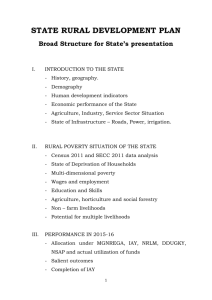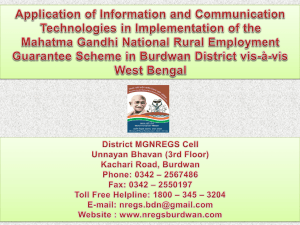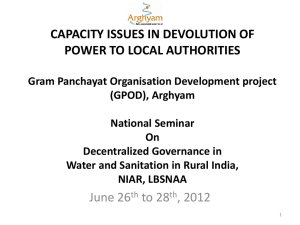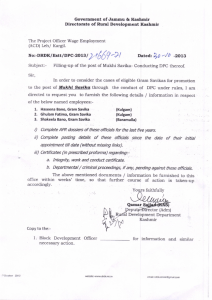Presentation by Jharkhand on Yojana Banao Abhiyaan in
advertisement
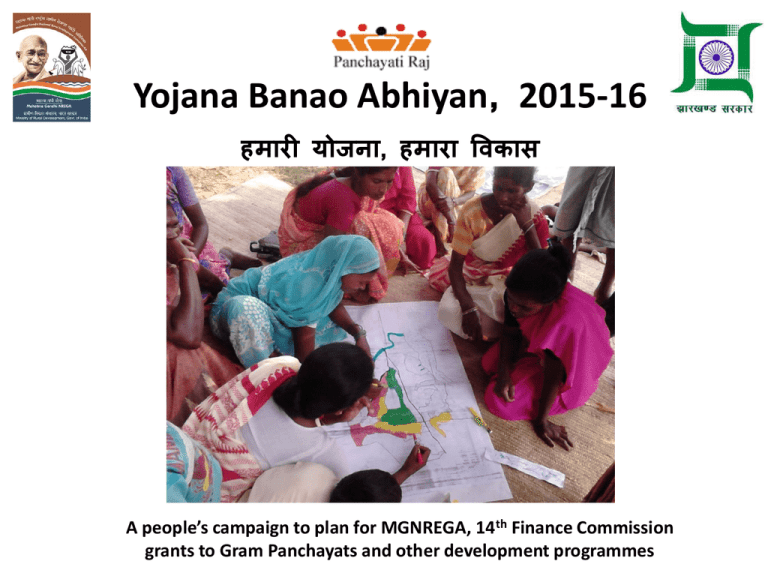
Yojana Banao Abhiyan, 2015-16 हमारी योजना, हमारा विकास A people’s campaign to plan for MGNREGA, 14th Finance Commission grants to Gram Panchayats and other development programmes Yojana Banao Abhiyan - Objectives • Preparation of participatory village-level plans for livelihoods enhancement based on integrated natural resource management (INRM) principles and for improving basic services of all villages in Jharkhand • Intensive livelihood planning of extremely vulnerable families • Preparation of comprehensive Gram Panchayat Development Plans based on Village Development Plans prepared by Gram Sabhas • Implementation of plans through MGNREGA, 14th Finance Commission grants to Gram Panchayats and convergence with line departments • Preparation of plans for utilisation of 14th Finance Commission grants to Gram Panchayats for 2015-16 and 2016-17 for improving/constructing school buildings and anganwadi centres, drinking water systems, community toilets, playgrounds etc • Activating Gram Panchayats and unlocking Panchayat Bhavans by triggering decentralisation of planning processes Yojana Banao Abhiyan - Structure • Gram Panchayats leading all Gram Panchayat-level activities • In each Gram Panchayat, planning being facilitated by a Panchayat Planning Team comprising of the Gram Rozgar Sewak, two Ward Members and two community planners • Panchayat Planning Teams being trained and supported by the State Resource Team members of the district comprising of civil society members, CFT members, JSLPS officers, government officials and functionaries, PMRDFs, PRI trainers and IWMP officials • Women collective members supporting Gram Panchayats in awareness generation and participatory planning exercises • Steering Committees formed at block and district levels for coordinating and monitoring Abhiyan activities Key facets of the Abhiyan Jan Abhiyan Priority of the political leadership Steering platform comprising Panchayati Raj, MGNREGA Cell and JSLPS Convergence with line departments Workshops with various stakeholders Large-scale capacity building programmes Wide media coverage Mobilisation activities • Series of meetings with civil society representatives, women collective representatives, University Vice Chancellors, media etc • Weekly state-level media briefings • Radio jingles and TV announcements in local languages • Participation of Hon’ble MLAs and MPs in Abhiyan activities across the state • Large-scale rallies, jaagrukta rath, miking, wall writing, hoardings, posters etc across the state • Orientation of field level Mediapersons Capacity building and orientation events Types of event Number of events Number of persons trained 5-days state-level training for state resource team members 15 700 One-day orientation of BDOs, BPOs and BPROs 5 650 5-days block-level training for Panchayat Planning Teams 400 22010 Training Events Workshops State-level launching workshop and orientation of DCs and DDCs 1 District-level launching workshop 24 Block-level launching workshop 259 Block-level orientation workshop with women collectives 259 Block-level orientation workshop with all Gram Panchayat representatives 259 Monitoring and Hand-holding Structure Thematic support mechanism • Detailed modules and presentations prepared for each activity, to ensure standardisation of information dissemination • Simple checklists prepared for monitoring quality of activities • Hand-holding support to blocks and district by state Abhiyan team • Regularly seeking qualitative feedback from state resource team members • Dedicated state-level helpline setup for Abhiyan • Google group, facebook page, and website created for dissemination of information • Abhiyan handbook distributed to each Panchayat Planning team member • Large-scale distribution of Abhiyan flyer and primer on MGNREGA Monitoring Mechanism • Weekly meeting of Panchayati Raj department, MGNREGA Cell and JSLPS, under the chairpersonship of Principal Secretary, RDD to review the progress of the Abhiyan • Weekly micro-detailed task-responsibility list prepared and followed • District-level civil society monitors appointed for qualitative monitoring of activities • Departmental Secretaries nominated for district-level monitoring • Weekly reporting formats prepared for blocks and districts Monitoring Mechanisms • Divisional WhatsApp groups comprising of district and block administration and local state resource team members setup for easy dissemination of information • Core Abhiyan Team tasked to monitor at district level more intensively • Random calls to BDOs/BPOs/SRTs etc. • Follow Up through multiple media Ongoing activities of the Abhiyan Panchayat-level workshop on the Abhiyan Meeting amongst Gram Panchayat representatives, members of women collectives (SHG, VO, Federation), civil society organisation representatives and Panchayat Planning Team to discuss about the Abhiyan in the Panchayat Bhawan Three Day Hamletlevel Planning Process First Day: Hamlet-level discussion Discussion on livelihoods, natural resources, basic services, MGNREGA, utilisation of 14th FC grants to be given to Gram Panchayats and participatory planning with villagers. Social Mapping Mapping of social structure, basic services (and issues) etc. Identification of workers without job cards and/or bank account. Livelihood discussion with vulnerable households Intensive discussion with vulnerable households on livelihoods Second Day: Resource Mapping Mapping of natural resources of the village (like forest, land, river etc) and identification of a few land patches which have land of vulnerable households or requires INRM treatment Transect Walk Identification of issues in the land patches and accordingly selecting schemes Budget estimation and plan documentation Panchayat Planning Team to prepare labour budget and document all proposed schemes Third Day: Household Livelihood Survey of vulnerable families Survey on livelihoods with households having three or more deprivation criteria as per SECC Tola Sabha for plan finalisation Prioiritisation of all identified schemes as per labour budget and needs of the hamlet Gram Panchayat Executive Committee Meeting Meeting in the Panchayat Bhavan to discuss and compile schemes approved by the gram sabha and prepare the “Gram Panchayat Development Plan” Expected Outcomes • Preparation of MGNREGA labour budget for 2016-17 based on people’s demand for employment • Preparation of Gram Panchayat Development Plan for enhancing livelihoods, generating employment, improving access to irrigation and strengthening basic services in all villages and Gram Panchayats of the state • Immense potential of reduction of rural poverty by implementation of the planned schemes • Skill enhancement of more than 20,000 people in participatory planning, INRM technologies and MGNREGA processes • Creation of a “State Resource Team” for providing technical support to Gram Panchayats and helping people access their entitlements • Strengthening democratic decentralization by increasing people’s participation in local governance • Providing the newly elected Gram Panchayats with a ready “task list” for the coming years Learnings • Orientation of BDOs/BPOs is necessary • Careful selection of Panchayat Planning Team members • More orientation of Panchayat Representatives needed • Monitoring mechanisms are critical to health of Abhiyan • Political will is needed • Sensitization for priority to water conservation works is necessary

